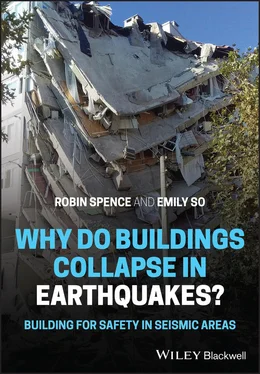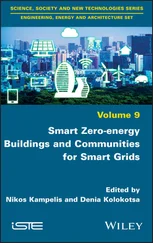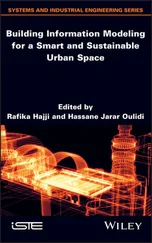Chapter 3looks at how buildings are constructed in the world's most earthquake‐prone regions. It considers first how the local climate affects local patterns and traditions of building, and shows how those traditional building forms affect earthquake performance. The world's areas of the greatest earthquake risk are then subdivided into 10 separate zones, and the patterns of building typical of each are described and illustrated, distinguishing rural and urban types.
Chapter 4explains what causes earthquakes, and shows how the ground motions caused by them are felt by buildings and how buildings respond. It also considers other ways in which earthquakes can affect buildings through ground deformation, landslides, tsunamis and fire outbreaks, and points to the growing risk of compound disasters triggered by earthquakes.
Chapter 5considers how buildings of different types of construction respond to the principal earthquake hazard of ground shaking. It classifies buildings into their different types and subtypes according to the main material of the load‐resisting system – masonry, reinforced concrete, timber and steel. For each main type, it describes the typical behaviour in an earthquake from the onset of damage to collapse, based on field observations. And it suggests cost‐effective ways in which each type of building could be made more earthquake‐resistant. Chapter 5also compares the earthquake vulnerability of different building types, showing the wide disparities that exist within the global building stock.
Chapter 6looks at human casualties caused by earthquakes. It identifies the main causes of casualties, and how these relate both to building performance and to occupant behaviours. It shows how the expected number of casualties from a particular earthquake can be estimated for loss modelling, using either statistical or engineering approaches.
Chapter 7considers different routes by which the earthquake resistance of buildings can be improved. It looks first at the engineering design of buildings and how codes of practice are used to achieve acceptable safety levels, both in the construction of new buildings and in the strengthening of existing buildings, and discusses associated costs. It also considers limitations in the effectiveness of building control regulations and implementation of codes of practice, and describes how building for safety programmes have been used to improve the construction of non‐engineered building in poorer countries.
Chapter 8reports on a global survey of the successes and failures of earthquake protection, country by country, based on responses from 39 experts in 28 different countries. For each responding country, the identified successes and failures are examined, and the countries are divided into three groups ‘high achievers’, ‘limited achievers’ and those with ‘continuing and growing risks’, indicating the wide disparity of performance across the world.
What is technically possible will only be achieved by the action of individuals and society as a whole, and its institutions. Thus, Chapter 9concludes the book with an examination of what part different organisations and groups of people can play in meeting the overall challenge of earthquake protection. The separate roles of governments (national and local), non‐government organisations (NGOs), the scientific and professional community, businesses, homeowners and individual citizens and the insurance industry are considered, and suggestions are made for ways in which each group could act more effectively.
Emphasising the message that it is ultimately the action of individuals that counts, the book contains a series of profiles (located as boxes within the appropriate chapters) of some individuals – ‘game‐changers’ – whose actions have made a notable contribution to earthquake protection in their particular situation. These advocates show what we can do with the knowledge to build safe buildings before an earthquake strikes and to stop preventable deaths. Earthquakes are an underrated hazard: but by ensuring safe buildings and earthquake awareness before the earthquakes strike, we can make the threat unremarkable.
1 Bilham, R. (2009). The seismic future of cities. Bulletin of Earthquake Engineering 7: 839–887.
2 Jones, L. and Benthian, M. (2011). Preparing for a “big one”: the great Southern California shakeout. Earthquake Spectra 27: 575–595.
3 Moullier, T. and Krimgold, F. (2015). Building Regulation for Resilience: Managing Risks for Safer Cities. Washington, DC: GFDRR, The World Bank.
4 Munthe, A. (1929). The Story of San Michele. London: John Murray.
5 Musson, R. (2012). The Million Death Quake. Palgrave Macmillan.
6 So, E.K.M., Pomonis, A., Below, R. et al. (2012). An Introduction to the Global Earthquake Consequences Database (GEMECD). Lisbon: 15 WCEE.
7 Udias, A. and Lopez Arroyo, A. (2009). The Lisbon earthquake of 1755 in Spanish contemporary authors. In: The 1755 Lisbon Earthquake Revisited (eds. L. Mendez‐Victor and C. Oliveira). The Netherlands: Springer.
2 How Do Buildings Behave in Earthquakes?
2.1 Learning from Earthquakes
When a large earthquake occurs, it causes human casualties, damages buildings and infrastructure, and affects livelihoods, society and the wider economy. It also sets in motion a process of relief and recovery, damage assessment and then rebuilding, carried out by governments, NGOs, commercial firms and individual households. It is important that the experience of each earthquake is recorded in detail, and that the lessons learnt are identified and passed on, both for the benefit of the affected country in its attempt to improve preparation for subsequent earthquakes, and also for the international community. Much of the damage caused by an earthquake is visible only for a short time, because demolition and rebuilding often start within a few days, so it is important that damage investigations start rapidly after an event. But it is equally important that, if they are to be useful for international comparison, such investigations should be done in a systematic way.
The need for speedy but systematic post‐earthquake investigations has led to the formation of a number of international earthquake reconnaissance teams whose aim is to be available for rapid deployment after an earthquake. They are composed of earthquake specialists from different disciplines, and generally include team members from the affected country. Each team conducts a survey whose exact scope depends on the scale and type of damage. But the study generally includes investigations of the seismological and geotechnical aspects of the event, the damage to buildings and to infrastructure, and the way in which relief and rescue has been conducted. On return, the team produces a report which is available to all who are interested, and is commonly made available on openly accessible websites. The team also communicates the findings through various technical meetings.
The Learning from Earthquakes programme of the California‐based Earthquake Engineering Research Institute (EERI) has the most experience of such field reconnaissance missions, and has conducted more than 150 investigations since it began after the 1971 San Fernando, California earthquake. In the United Kingdom, the Earthquake Engineering Field Investigation Team (EEFIT), working in conjunction with the UK's Institution of Structural Engineers, has conducted more than 30 investigations since its formation in 1982 following the Irpinia (Italy) earthquake of 1980. Similar organisations exist in several other countries (Spence 2014). The cumulative findings of the missions have been very influential in formulating research programmes which have studied aspects of the physical damage, response and recovery from multiple events. And these research programmes in turn have led to steady improvements of national and international codes of practice for building, as well as assisting in understanding the vulnerability of different types of affected facilities and in developing ways to enhance earthquake safety internationally (EERI 1986; Spence 2014).
Читать дальше












